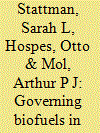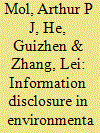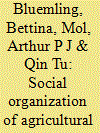|
|
|
Sort Order |
|
|
|
Items / Page
|
|
|
|
|
|
|
| Srl | Item |
| 1 |
ID:
126476


|
|
|
|
|
| Publication |
2013.
|
| Summary/Abstract |
Under the dual pressures of an energy crisis and rising greenhouse gas emissions, biomass energy development and utilisation has become part of the national energy strategy in China. The last decade has witnessed a strong promotion of both centralised and decentralised bio-energy systems in rural China. The government seems to have a strong preference for centralised (village-based) bio-energy systems in recent years. However, these government-driven systems have not worked without difficulties, particularly regarding economic and technological viability and maintenance. Studies on the advantages and disadvantages of decentralised and centralised bio-energy systems are rare. This study aims to shed light on the performances of these two systems in terms of social, economic and environmental effects. Through interviewing local officials and village leaders and surveying farmers in 12 villages in Shandong Province, it was found that bio-energy systems should be selected based on the local circumstances. The diversity of the local natural, economic and social situations determines the size, place, technology and organisational model of the bio-energy system.
|
|
|
|
|
|
|
|
|
|
|
|
|
|
|
|
| 2 |
ID:
119791


|
|
|
|
|
| Publication |
2013.
|
| Summary/Abstract |
Reducing the climate impact of rural household energy consumption in China is complicated since it is bound up with deeply routinized daily practices and dependent from existing infrastructural systems of energy supply. To assess the potential for low carbon development we first estimate the overall CO2 emissions of rural households, followed by a more in depth description and characterization of the different energy use practices within the households. Space heating turns out to be the largest emission source among domestic energy practices in north China. We present lifestyle and context related factors that help to explain existing differences in domestic energy use practices of households. The potential for low carbon development is discussed both at the demand side and the supply side. At the demand side, the use of more efficient technologies and cleaner energy sources for space heating seems to be a high potential measure for achieving low carbon households. At the supply side the reduction of rural domestic CO2 emissions could be effectively supported by making available to householders renewable and cleaner energy sources and technologies. In order to be effective, such low carbon energy options should take into account the (income) characteristics and lifestyles of rural householders.
|
|
|
|
|
|
|
|
|
|
|
|
|
|
|
|
| 3 |
ID:
125486


|
|
|
|
|
| Publication |
2013.
|
| Summary/Abstract |
Over the last decade Brazil has implemented a new and ambitious biofuel program: the National Program of Production and Use of Biodiesel (PNPB). When launching this program in 2004 the government stated that it wanted to avoid the same kind of geographical concentration, single crop focus, dominance of agribusiness, and exclusion of family farmers that have occurred with bioethanol production through the ProÁlcool policy since 1975. This paper compares the life histories of the bioethanol and the biodiesel policies of Brazil by analyzing their substantive policy content; the power and politics of actors that struggle for the design and implementation of the policies; and the polity in terms the organization and institutionalization of the policies. The paper concludes that both policies have become submerged by and dependent on the polity and politics of primarily the energy and agricultural sectors that operate as the two semi-autonomous governance fields. This submerging has shaped the substantive contents of biofuels policies, and explains why the 2004 biodiesel policy PNPB, in spite of its objectives for social inclusion and rural development, faces similar problems in implementation as its predecessor, the 1975 bioethanol policy ProÁlcool.
|
|
|
|
|
|
|
|
|
|
|
|
|
|
|
|
| 4 |
ID:
110498


|
|
|
|
|
| Publication |
2011.
|
| Summary/Abstract |
Trust and property rights are generally considered to influence farmers' behavior regarding resource use and environmental management. Previous studies show that higher trust levels may enhance contributions to public goods. This paper investigates how trust and (land) property rights security influence the provision of one concrete public good: land protection through the Sloping Land Conservation Program in China. The analysis is based on household survey data from Ningxia Autonomous Region in China. From our questionnaire two trust factors are derived and distinguished, using factor analysis: general trust and kinship trust. Farm households are less likely to contribute to public goods when they perceive more secure land rights, but trust has mixed effects on public goods. The results show that general trust and kinship trust may rely on two opposite effects for influencing public goods provision. On the one hand, high levels of general trust may directly enhance people's willingness to provide contributions to public goods (by reduced likelihood to reconvert forest land) when farmers are aware of the positive environmental effects of the program, that's the public goods effect. On the other hand, general trust may also make it more likely that people invest more in their own private goods to pursue their own welfare (a more likely reconversion of forest land to arable land), that's the private goods effect. The final outcome depends on the size and direction of both effects. Compared to general trust, kinship trust is more inward-looking and self- or group-interested compared to more reciprocal general trust. Thus, unlike general trust, kinship trust may have no significant public goods effect on the provisioning of public goods.
|
|
|
|
|
|
|
|
|
|
|
|
|
|
|
|
| 5 |
ID:
108601


|
|
|
| 6 |
ID:
126478


|
|
|
|
|
| Publication |
2013.
|
| Summary/Abstract |
In many of the least developed countries the energy security conundrum is how to provide affordable, safe and clean energy to a low income rural population. Household level generation of biogas from animal waste for both cooking and lighting, while producing high quality organic fertiliser, is increasingly proposed as a viable part of the solution for farming households. Since the early 1990s international development organisations - often in cooperation with the national government - have attempted to introduce biogas technologies in many least developed countries, but most initiatives failed. In this landscape of failed biogas development programmes the National Biodigester Programme (NBP) Cambodia started in 2006, with the aim to establish a permanent market oriented and self-financed biogas sector. The results show the development of a sustainable domestic biodigester sector, a rapid diffusion of biodigesters among poor rural households, but still ambivalences on financial independency from external funding and carbon finance. The conclusion is that a pure market model for biogas development in the rural area of the least developed countries will not easily work. Governmental regulation and coordination will remain needed, and carbon finance will not easily fully replace ODA and governmental financial support.
|
|
|
|
|
|
|
|
|
|
|
|
|
|
|
|
| 7 |
ID:
116936


|
|
|
|
|
| Publication |
2012.
|
| Summary/Abstract |
Despite high-speed economic growth in recent decades, rural China is still confronted with persisting poverty, alongside energy shortages and environmental degradation. In tackling climate change, carbon emissions from rural energy use have been given little attention up till now. This paper provides an analysis of rural residential CO2 emissions in China based on diverse accounting methods, and employs the geographic information system (GIS) to map emissions of each province. Identifying the major emission sources could provide a basis for understanding the potential for greenhouse gas emission reduction and proposing related policy recommendations. The results showed that the largest GHG mitigation potential can be found at traditional biomass use among residents. Four emission reduction policy strategies are identified: (i) shifting to commercial energy; (ii) furthering the use of decentralized renewable energy options; (iii) commercializing biomass energy via biomass power generation, biomass briquettes and biogas production; (iv) improving the combustion efficiency of traditional biomass use in household appliances. Differences in resource endowment and local economic conditions created varied levels of rural residential greenhouse gas emission, the related mitigation potential, and the kinds of strategies and policies that need to be developed in the Chinese provinces.
|
|
|
|
|
|
|
|
|
|
|
|
|
|
|
|
| 8 |
ID:
126473


|
|
|
|
|
| Publication |
2013.
|
| Summary/Abstract |
While for wind, solar energy or hydropower, energy supply happens directly from the source to the wind wheels, hydropower turbines or solar panels, in the case of biogas, energy production cannot directly take from the energy source, organic matter, but depends on the institutional structures and farmers' practices involved for making energy available. With the production of bioenergy in rural areas, practices within agriculture are transformed, requiring new ways of organizing production processes. Research has left the question largely unanswered of how agricultural biogas production and use are - and can best be - organized within rural society. Which kinds of social organization exist, how are these embedded in existing agricultural institutions and practices, and how do these systems function? Under which conditions may the different kinds of social organization of biogas production and use work sustainably? This introduction article to the Special Issue "The social organization of agricultural biogas production and use" presents a framework for analysing the different kinds of social organization of biogas production and use presented hereafter. Analysis parameters are the supply network, distribution network, distribution of benefits, social boundaries of the system (accessibility) and scale. Using these parameters, the Special Issue articles are outlined.
|
|
|
|
|
|
|
|
|
|
|
|
|
|
|
|
| 9 |
ID:
093511


|
|
|
|
|
| Publication |
2010.
|
| Summary/Abstract |
Solar thermal utilization, especially the application of solar water heater technology, has developed rapidly in China in recent decades. Manufacturing and marketing developments have been especially strong in provinces such as Zhejiang, Shandong and Jiangsu. This paper takes Zhejiang, a relatively affluent province, as a case study area to assess the performance of solar water heater utilization in China. The study will focus on institutional setting, economic and technological performance, energy performance, and environmental and social impact. Results show that China has greatly increased solar water heater utilization, which has brought China great economic, environmental and social benefits. However, China is confronted with malfeasant market competition, technical flaws in solar water heater products and social conflict concerning solar water heater installation. For further development of the solar water heater, China should clarify the compulsory installation policy and include solar water heaters into the current "Home Appliances Going to the Countryside" project; most of the widely used vacuum tube products should be replaced by flat plate products, and the technology improvement should focus on anti-freezing and water saving; the resources of solar water heater market should be consolidated and most of the OEM manufacturers should evolve to ODM and OBM enterprises.
|
|
|
|
|
|
|
|
|
|
|
|
|
|
|
|
| 10 |
ID:
096638


|
|
|
|
|
| Publication |
2010.
|
| Summary/Abstract |
It is widely acknowledged that Russia possesses enormous biomass resources (Hoogwijk et al., 2005). Its vast areas devoted to agricultural production and plentiful timber resources suggest good prospects for the development of liquid biofuel production. However, no significant advances in this direction have been reported till now. None of the numerous investment projects announced at the heydays of biofuel excitement in Russia (2006-2008) are at the moment commercially operating. There are no specialised plants for the production of bioethanol and biodiesel in Russia. Little is known of the reasons for this discrepancy between biofuel potential and actual development. In investigating this discrepancy, this article analyses national developments and investigates local dynamics through a case-study in the Omsk region. It is found that the reasons for this discrepancy are not related to technological incapabilities, but are to be found in the low policy and institutional priority given to non-fossil fuel exploitation and lack of market opportunities. Sprouts of second generation liquid biofuel technologies can be identified within the state system, but it remains to be seen how strong and how long these will be supported by the Russian state.
|
|
|
|
|
|
|
|
|
|
|
|
|
|
|
|
| 11 |
ID:
097476


|
|
|
|
|
| Publication |
2010.
|
| Summary/Abstract |
It is widely acknowledged that Russia possesses enormous biomass resources (Hoogwijk et al., 2005 ). Its vast areas devoted to agricultural production and plentiful timber resources suggest good prospects for the development of liquid biofuel production. However, no significant advances in this direction have been reported till now. None of the numerous investment projects announced at the heydays of biofuel excitement in Russia (2006?2008) are at the moment commercially operating. There are no specialised plants for the production of bioethanol and biodiesel in Russia. Little is known of the reasons for this discrepancy between biofuel potential and actual development. In investigating this discrepancy, this article analyses national developments and investigates local dynamics through a case-study in the Omsk region. It is found that the reasons for this discrepancy are not related to technological incapabilities, but are to be found in the low policy and institutional priority given to non-fossil fuel exploitation and lack of market opportunities. Sprouts of second generation liquid biofuel technologies can be identified within the state system, but it remains to be seen how strong and how long these will be supported by the Russian state.
|
|
|
|
|
|
|
|
|
|
|
|
|
|
|
|
|
|
|
|
|